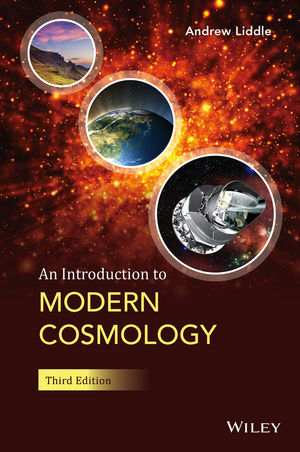
An Introduction to Modern Cosmology
John Wiley & Sons Inc (Verlag)
978-1-118-50209-9 (ISBN)
This fully revised edition of a bestseller takes an approach which is grounded in physics with a logical flow of chapters leading the reader from basic ideas of the expansion described by the Friedman equations to some of the more advanced ideas about the early universe. It also incorporates up-to-date results from the Planck mission, which imaged the anisotropies of the Cosmic Microwave Background radiation over the whole sky. The Advanced Topic sections present subjects with more detailed mathematical approaches to give greater depth to discussions. Student problems with hints for solving them and numerical answers are embedded in the chapters to facilitate the reader’s understanding and learning.
Cosmology is now part of the core in many degree programs. This current, clear and concise introductory text is relevant to a wide range of astronomy programs worldwide and is essential reading for undergraduates and Masters students, as well as anyone starting research in cosmology.
The accompanying website for this text, http://booksupport.wiley.com, provides additional material designed to enhance your learning, as well as errata within the text.
Andrew Liddle Institute for Astronomy, University of Edinburgh, UK
Preface xi
Constants, conversion factors and symbols xiv
1 A (Very) Brief History of Cosmological Ideas 1
2 Observational Overview 3
2.1 In visible light 3
2.2 In other wavebands 6
2.3 Homogeneity and isotropy 10
2.4 The expansion of the Universe 10
2.5 Particles in the Universe 13
3 Newtonian Gravity 21
3.1 The Friedmann equation 22
3.2 On the meaning of the expansion 25
3.3 Things that go faster than light 25
3.4 The fluid equation 26
3.5 The acceleration equation 27
3.6 On mass, energy and vanishing factors of c2 28
4 The Geometry of the Universe 29
4.1 Flat geometry 29
4.2 Spherical geometry 30
4.3 Hyperbolic geometry 32
4.4 Infinite and observable Universes 33
4.5 Where did the Big Bang happen? 33
4.6 Three values of k 34
5 Simple Cosmological Models 37
5.1 Hubble’s law 37
5.2 Expansion and redshift 38
5.3 Solving the equations 39
5.4 Particle number densities 43
5.5 Evolution including curvature 44
6 Observational Parameters 49
6.1 The expansion rate H0 49
6.2 The density parameter 0 51
6.3 The deceleration parameter q0 52
7 The Cosmological Constant 55
7.1 Introducing _ 55
7.2 Fluid description of _ 56
7.3 Cosmological models with _ 57
8 The Age of the Universe 61
9 The Density of the Universe and Dark Matter 67
9.1 Weighing the Universe 67
9.2 What might the dark matter be? 73
9.3 Dark matter searches 74
10 The Cosmic Microwave Background 77
10.1 Properties of the microwave background 77
10.2 The photon to baryon ratio 79
10.3 The origin of the microwave background 80
10.4 The origin of the microwave background (advanced) 83
11 The Early Universe 87
12 Nucleosynthesis: The Origin of the Light Elements 93
12.1 Hydrogen and Helium 93
12.2 Comparing with observations 96
12.3 Contrasting decoupling and nucleosynthesis 98
13 The Inflationary Universe 101
13.1 Problems with the Hot Big Bang 101
13.2 Inflationary expansion 105
13.3 Solving the Big Bang problems 106
13.4 How much inflation? 108
13.5 Inflation and particle physics 109
14 The Initial Singularity 113
15 Overview: The Standard Cosmological Model 117
Advanced Topic 1 General Relativistic Cosmology 121
1.1 The metric of space-time 121
1.2 The Einstein equations 122
1.3 Aside: Topology of the Universe 124
Advanced Topic 2 Classic Cosmology: Distances and Luminosities 127
2.1 Light propagation and redshift 127
2.2 The observable Universe 130
2.3 Luminosity distance 130
2.4 Angular diameter distance 134
2.5 Source counts 136
Advanced Topic 3 Neutrino Cosmology 139
3.1 The massless case 139
3.2 Massive neutrinos 141
3.3 Neutrinos and structure formation 142
Advanced Topic 4 Baryogenesis 145
Advanced Topic 5 Structures in the Universe 149
5.1 The observed structures 149
5.2 Gravitational instability 151
5.3 The clustering of galaxies 152
5.4 Cosmic microwave background anisotropies 154
5.5 The origin of structure 159
Advanced Topic 6 Constraining cosmological models 163
6.1 Cosmological models and parameters 163
6.2 Key cosmological observations 164
6.3 Cosmological data analysis 164
6.4 The Standard Cosmological Model: 2014 edition 166
6.5 The future 168
Bibliography 171
Numerical answers and hints to problems 173
Index 177
| Erscheint lt. Verlag | 7.7.2015 |
|---|---|
| Verlagsort | New York |
| Sprache | englisch |
| Maße | 158 x 235 mm |
| Gewicht | 390 g |
| Themenwelt | Naturwissenschaften ► Physik / Astronomie ► Astronomie / Astrophysik |
| ISBN-10 | 1-118-50209-4 / 1118502094 |
| ISBN-13 | 978-1-118-50209-9 / 9781118502099 |
| Zustand | Neuware |
| Haben Sie eine Frage zum Produkt? |
aus dem Bereich


